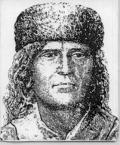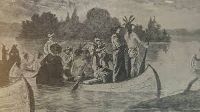The Explorer Louis Jolliet
Louis Jolliet, one of North America's most famous early explorers, was born on Sept. 21, 1645, in what is now Quebec. A skilled musician (at both harpsichord and organ) and an excellent student (particularly in mathematics), he nonetheless preferred the pursuit of adventure and, after a time studying religion and a brief stint in the fur trade, got himself a commission to explore the western parts of New France. 
Governor Louis de Buade de Frontenac sent him on an expedition to find the Pacific Ocean and, with luck, the Northwest Passage, a fabled sea route thought to connect Atlantic and Pacific Oceans. He arrived in 1672 in St. Ignace, where he met Father Jacques Marquette, who joined the expedition that made the pair famous. 
In May 1673, they set off. They were also looking for the fabled Northwest Passage, a sea route connecting the Atlantic Ocean and the Pacific Ocean. The pair, along with a handful of other French explorers, paddled their canoes across Lake Michigan to what is now Green Bay. They turned up the Fox River to what is now Portage, Wis., and then did what the name suggests–carry their canoes–overland to the Wisconsin River. They carried on down that river and, on June 17, encountered the broad expanse of the mighty Mississippi. Marquette and Jolliet paddled down the Mississippi, at one point encountering a peaceful group of the Illinois tribe, whose chief presented them with a calumet, or peace pipe. Onward they went. When they reached the mouth of the Arkansas River, they found themselves surrounded by another tribe, armed with guns. By showing the calumet, the French explorers convinced the Native Americans to put down their guns and have a discussion, during which Marquette and Jolliet learned that further south were many more men armed with many more guns–Spanish explorers who were out for conquest. The French explorers returned north, taking a slight detour up the Illinois River, passing by what is now Chicago at one point. They returned to Canada, having traversed more than 2,500 miles in four months. They did their duty by claiming all of the land that they could see for their king, Louis XIV of France. 
The pair went their separate ways after that. Jolliet went on to Sault Sainte Marie and then to Quebec. On the return journey, he narrowly escaped death when the canoe he was paddling capsized over a group of rapids. Jolliet lost his maps and his logbook but survived, unlike others in the canoe. He married a woman named Claire-Francoise Bissot and returned to the fur trade. He gained ownership of the Island of Anticosti in 1680 and had built there a fort. In 1697, he got a job as a teacher of hydrography at the Jesuit College of Quebec, which he had attended some years before. King Louis XIV appointed him royal hydrographer. Among his projects was drawing navigation maps of the St. Lawrence Gulf and the St. Lawrence River. Jolliet kept on wandering, exploring Labrador and beyond. He disappeared in May 1700, and his body was never found. Jolliet's journeys helped pave the way for further settlement in the areas he explored and helped expand the burgeoning fur trade. |
|
Social Studies for Kids
copyright 2002–2026
David White




